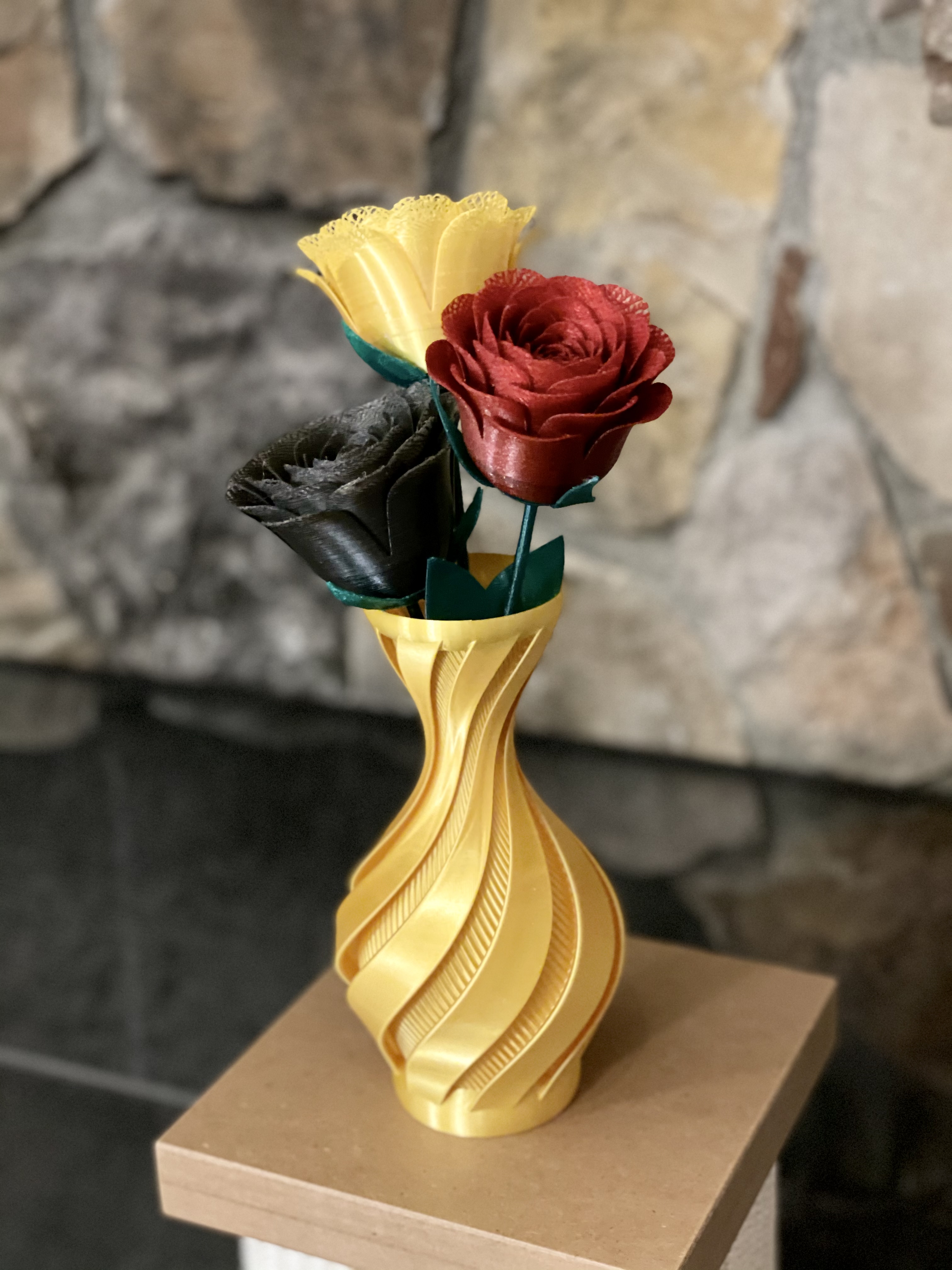
Selectively-Underextruded Flowers
prusaprinters
<p><i>Please note that the license for this print is for the layer-change G-code only. The </i><a href="https://www.thingiverse.com/thing:1715093"><i>Roses of Unicofil</i></a><i> flower used as an example remains “Attribution-NoDerivatives” and is itself unmodified in this print.</i></p><p> </p><p>By dynamically adjusting the flow-rate to very low values (as low as 25% in this example), it is possible to create a lacy effect on a print. </p><p>I originally tried using a linear adjustment (based on the ratio of <strong>layer_z</strong> and the part's height), but I found that the laciness wasn't good enough. What I wanted was a gentler adjustment so that more of the print would have higher density while the laciness starts and increases gradually at the top.</p><p>The best way I found to do that was to use a sinusoidal function based on the ratio of the <strong>layer_num</strong> versus the <strong>total_layer_count</strong>. Unfortunately, PrusaSlicer doesn't support sin(x) in the G-code placeholders; it only supports basic arithmetic.</p><p>Then I discovered the <a href="https://datagenetics.com/blog/july12019/index.html">Bhaskara I approximation</a> that gave me a way to convert the sine function into a basic algebraic formula:</p><figure class="image image-style-align-center image_resized" style="width:20.11%;"><img src="https://media.prusaprinters.org/media/prints/60049/rich_content/f084ffd9-9a66-4fe5-871f-8470f561c9a5/image.png#%7B%22uuid%22%3A%22fa3896a3-64a9-4ee2-b808-28d82b1c8941%22%2C%22w%22%3A114%2C%22h%22%3A43%7D"></figure><p>where x is:</p><figure class="image image-style-align-center image_resized" style="width:20.29%;"><img src="https://media.prusaprinters.org/media/prints/60049/rich_content/af4aba91-56af-4307-8f69-b4d7d17240db/image.png#%7B%22uuid%22%3A%22eb3389ed-89f3-40fb-9cb5-8bd741c1a3f1%22%2C%22w%22%3A99%2C%22h%22%3A38%7D"></figure><p>(<i>l</i> is <strong>layer_num</strong> and <i>t</i> is <strong>total_layer_count</strong>.)</p><p>Substituting x in gives us (including the 100% → 25% flow-rate range factor):</p><figure class="image image-style-align-center image_resized" style="width:84.7%;"><img src="https://media.prusaprinters.org/media/prints/60049/rich_content/0b84dc17-552f-462a-9534-779c2fac43ad/image.png#%7B%22uuid%22%3A%2214f33062-bd80-45f4-8a36-b047d9c70941%22%2C%22w%22%3A666%2C%22h%22%3A79%7D"></figure><p>That's quite complicated, but fortunately WolframAlpha simplified that down to just:</p><figure class="image image-style-align-center image_resized" style="width:30.51%;"><img src="https://scontent-iad3-1.xx.fbcdn.net/v/t1.0-9/161091054_10158890583511469_8321898798756325784_n.jpg?_nc_cat=104&ccb=1-3&_nc_sid=dbeb18&_nc_ohc=lySzZvBL79oAX9QpsJT&_nc_oc=AQlc6h58TyHHk0zx1WEfk-3cCqgbmlHVUajVKZnAjRxC0zKAf34lMZYhw7mtYkLBnqU&_nc_ht=scontent-iad3-1.xx&oh=aa72b791704496593abb75bf0a50413c&oe=6075A556" alt="No photo description available."></figure><p>That then translates to this G-code that does all the magic:</p><pre><code class="language-gcode">;AFTER_LAYER_CHANGE ;[layer_z] M221 S{min(95, 212.5 - (375.0 * total_layer_count * total_layer_count) / 2.0 / (layer_num * layer_num - 2.0 * layer_num * total_layer_count + 2.0 * total_layer_count * total_layer_count))}</code></pre><p> </p><p>This technique should work for lots of different items, not just flowers, although it may be possible to use this layer-change G-code as-is on other generally similarly-shaped flowers.</p><p> </p><p><i><strong>N.B. </strong>Hopefully this won't be a surprise to anyone. Due to the significant underextrusion, the top parts of the petals are fragile.</i></p>
With this file you will be able to print Selectively-Underextruded Flowers with your 3D printer. Click on the button and save the file on your computer to work, edit or customize your design. You can also find more 3D designs for printers on Selectively-Underextruded Flowers.
